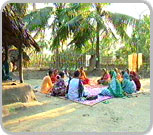Knowledge Transfer
|
KT4D Knowledge Transfer at Amader Gram |

At Amader Gram, Knowledge transfer is a way to transmit and disseminate knowledge from the trainer or teacher or scholar to the learners. It can be defined as, “The dissemination and exploitation of the outputs of higher education - research, knowledge, skills, expertise or ideas to achieve economic, educational, social, healthcare and cultural benefits for society”.
For us, Knowledge transfer is a systematic approach to capture, collect and share tacit knowledge in order for it to become explicit knowledge. By doing so, this process allows for individuals and/or organizations to access and utilize essential information, which previously was known intrinsically to only one or a small group of people.
The knowledge transfer in Amader Gram has achieved through different steps and actions. These are:
1) Creativity: it is the focal point of transferring knowledge. Without creativity knowledge cannot create its urge to the learners and remains unshared which causes the death of knowledge. Creative actions will transform knowledge from person to person and creativity will give birth to creative ideas and thus knowledge will be shared and enhanced.
2) Sharing: it is another vital step for knowledge to move. Sharing means to include and expose the learners to the ideas so knowledge is properly gained and disseminated among all.
3) Evaluation: the trainer or the teacher must evaluate his/her new and creative ideas and go for the effective ones. Evaluation we do between present and past works so the learning will become more competitive.
4) Dissemination: without dissemination the acquired knowledge can never be judged as shared. The dissemination of knowledge must happen at all level and should reach the human mind.
5) Adoption: the adoption of particular knowledge to the particular place is also very important. In the present world there is free flow of information through both print and electronic media. The right kind of knowledge should reach to the particular where it has been needed.
These steps are the ones that we follow and ensure to transfer knowledge for the growth of knowledge thus for the growth of power to know. The ability of knowing is the greatest power of all time.
Example of KT4D at Amader Gram by BFES
1. A base line survey shows that the morbidity rate from diarrhea disease is unexpectedly high, 10%, in Rampal Upazila in Bagerhat district. The BFES has the knowledge that this morbidity can be brought dawn to 2% by ensuring access to safe drinking and sanitation.
In this case, the analysts did the survey & the BFES experts were with the knowledge of how the health scenario can be improved. The change leaders of BFES took the initiative to transfer the knowledge to the villagers/learners with the help of the Amader Gram Knowledge Workers and BFES experts to bring down the morbidity rate.
2. The use of sanitary latrine and tube-well has been increased by 80% in last seven years in Rampal upazila of Bagerhat district, The diarrhea morbidity rate has been decreased by 70%; it is predicted that if the access to safe drinking water and sanitation can be ensured, the diarrhea morbidity rate can be brought dawn to 0% by 2006.
In this case the information from several years has been applied to have an understanding of facts in the form of experience or learning to make a decision to predict the reduction of death rate from diarrhea. The decision and prediction are knowledge ; in other words the use of information .

